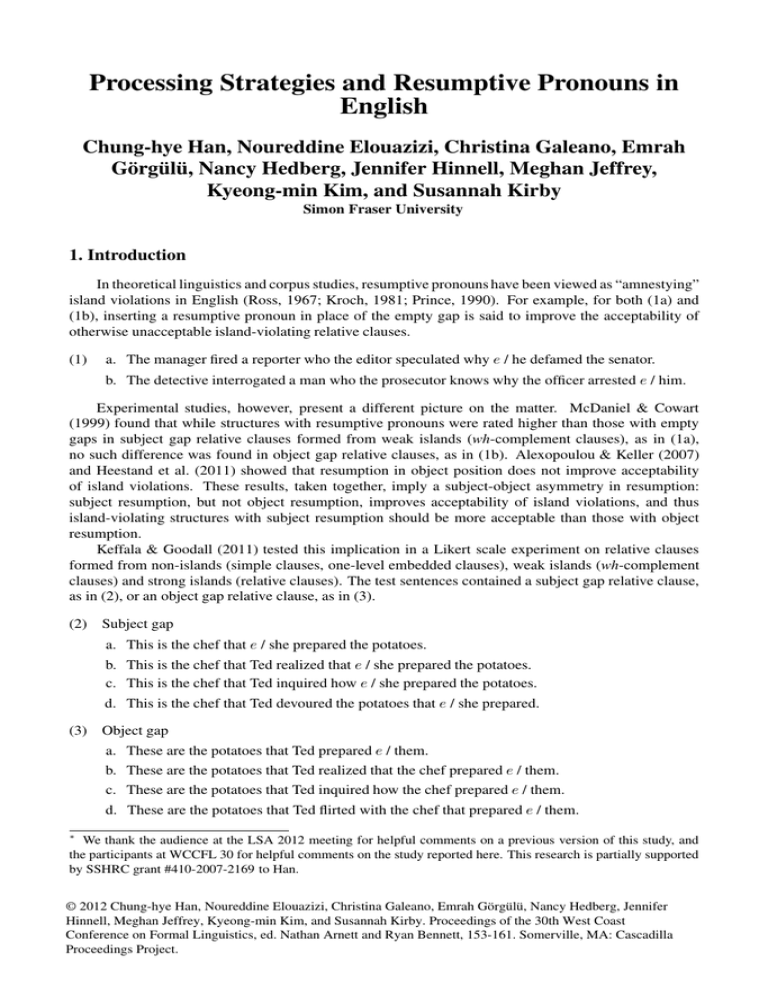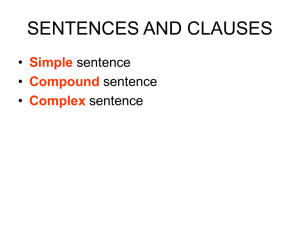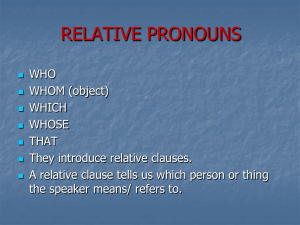
Processing Strategies and Resumptive Pronouns in
English
Chung-hye Han, Noureddine Elouazizi, Christina Galeano, Emrah
Görgülü, Nancy Hedberg, Jennifer Hinnell, Meghan Jeffrey,
Kyeong-min Kim, and Susannah Kirby
Simon Fraser University
1. Introduction
In theoretical linguistics and corpus studies, resumptive pronouns have been viewed as “amnestying”
island violations in English (Ross, 1967; Kroch, 1981; Prince, 1990). For example, for both (1a) and
(1b), inserting a resumptive pronoun in place of the empty gap is said to improve the acceptability of
otherwise unacceptable island-violating relative clauses.
(1)
a. The manager fired a reporter who the editor speculated why e / he defamed the senator.
b. The detective interrogated a man who the prosecutor knows why the officer arrested e / him.
Experimental studies, however, present a different picture on the matter. McDaniel & Cowart
(1999) found that while structures with resumptive pronouns were rated higher than those with empty
gaps in subject gap relative clauses formed from weak islands (wh-complement clauses), as in (1a),
no such difference was found in object gap relative clauses, as in (1b). Alexopoulou & Keller (2007)
and Heestand et al. (2011) showed that resumption in object position does not improve acceptability
of island violations. These results, taken together, imply a subject-object asymmetry in resumption:
subject resumption, but not object resumption, improves acceptability of island violations, and thus
island-violating structures with subject resumption should be more acceptable than those with object
resumption.
Keffala & Goodall (2011) tested this implication in a Likert scale experiment on relative clauses
formed from non-islands (simple clauses, one-level embedded clauses), weak islands (wh-complement
clauses) and strong islands (relative clauses). The test sentences contained a subject gap relative clause,
as in (2), or an object gap relative clause, as in (3).
(2) Subject gap
a. This is the chef that e / she prepared the potatoes.
b. This is the chef that Ted realized that e / she prepared the potatoes.
c. This is the chef that Ted inquired how e / she prepared the potatoes.
d. This is the chef that Ted devoured the potatoes that e / she prepared.
(3) Object gap
a. These are the potatoes that Ted prepared e / them.
b. These are the potatoes that Ted realized that the chef prepared e / them.
c. These are the potatoes that Ted inquired how the chef prepared e / them.
d. These are the potatoes that Ted flirted with the chef that prepared e / them.
∗
We thank the audience at the LSA 2012 meeting for helpful comments on a previous version of this study, and
the participants at WCCFL 30 for helpful comments on the study reported here. This research is partially supported
by SSHRC grant #410-2007-2169 to Han.
© 2012 Chung-hye Han, Noureddine Elouazizi, Christina Galeano, Emrah Görgülü, Nancy Hedberg, Jennifer
Hinnell, Meghan Jeffrey, Kyeong-min Kim, and Susannah Kirby. Proceedings of the 30th West Coast
Conference on Formal Linguistics, ed. Nathan Arnett and Ryan Bennett, 153-161. Somerville, MA: Cascadilla
Proceedings Project.
154
They found that in island conditions, while object resumptive relatives are rated as low as object empty
gap relatives, subject resumptive relatives are rated higher than subject empty gap relatives. But they
found no difference in acceptability between subject resumptive relatives and object resumptive relatives.
A conclusion that emerges from all these experimental studies is that resumption simply does not
“amnesty” island violations in English. This conclusion, however, is incompatible with the fact that
native speakers produce structures with resumption frequently in spontaneous speech, as reported in
Prince (1990) and Cann et al. (2005). We observe two points that may bear on the issue. First, in the
corpus studies (Prince, 1990; Ariel, 1999), it has been noted that resumptive pronouns are found much
more frequently in indefinite relative clauses than definite relative clauses. But the relative clauses tested
in Heestand et al. (2011) and Keffala & Goodall (2011) are definite. Second, resumption is known to be
a speech phenomenon in that structures with resumption are commonly found in speech rather than in
text. But all the experimental studies discussed above used text stimuli, and not audio stimuli.
We thus conducted two magnitude estimation (ME) task experiments, one with text stimuli and
the other with audio stimuli. The test sentences used in both experiments contained indefinite relative
clauses. The two experiments addressed the following research questions.
(4) Research questions
(i) Do resumptive pronouns improve the acceptability of subject gap indefinite relative clauses
formed from strong islands as well as weak islands?
(ii) In island indefinite relative clauses, are subject gap resumptive pronouns more acceptable than
object gap resumptive pronouns?
(iii) Is there any difference in results between the experiment with text stimuli and the one with
audio stimuli?
We found that in both text and audio experiments, while subject resumptive pronouns, but not object
resumptive pronouns, improve acceptability in island relative clauses, resumptive relative clauses receive
a uniformly low acceptability rating across clause types.
This paper is organized as follows. In section 2, we present the experiments and our findings. The
experiment with text stimuli is presented in subsection 2.1, and the experiment with audio stimuli is
presented in subsection 2.2. We discuss some implications of our findings in section 3, and conclude in
section 4 with a brief summary.
2. The experiments
2.1. Experiment 1
2.1.1. Task
An ME technique is standardly used in psychophysics to measure judgments of sensory stimuli
such as light or sound intensity (Stevens, 1975), and has been adopted for obtaining grammaticality
judgments in linguistics (Bard et al., 1996; Cowart, 1997). In our ME task experiment, participants were
first visually presented with a slightly degraded reference sentence on a computer screen. The sentence
was pre-assigned a reference score of 100. They then read and rated the acceptability of each subsequent
experimental sentence in proportion to the score assigned to the reference sentence. The participants
were instructed to rate the experimental sentences higher than the reference score if they were judged to
be more acceptable than the reference sentence, lower if judged to be less acceptable, and the same as
the reference score if judged to be as acceptable as the reference sentence.
2.1.2. Participants
Twenty three adult native speakers of English were tested. All were university students living in
Vancouver, Canada at the time of testing. Each one was paid $10 for participation.
155
2.1.3. Design
Three within-subjects factors with two levels each were tested: clause type (the relative clause
is either formed from a non-island or an island), gap type (the relative clause has an empty gap or a
resumptive pronoun) and gap position (the relative clause has a gap in the subject position or the object
position). The experiment was thus divided into eight conditions, each of which tested sentences that
contained subject gap or object gap relative clauses formed from non-islands or islands with empty gaps
or resumptive pronouns. The experimental design is summarized in Table 1.
Clause Type
Non-island
Gap type
Empty
Pronoun
Island
Empty
Pronoun
Gap position
Subject
Object
Subject
Object
Subject
Object
Subject
Object
Table 1: Summary of the experimental design
2.1.4. Materials
The sentence in (5) was used as a reference sentence. An ideal reference sentence in an ME task
should be marginal but not ungrammatical. Such a sentence with a mid-range acceptability encourages
participants to make as wide a distinction as possible between grammatical and ungrammatical test
items. Sentence (5) fits this criterion because although it is grammatical, it might result in processing
difficulties if read out of context, as the embedded clause contains both an it-cleft, and a pronoun with
multiple possible referents.
(5) The reporter suggested to his assistant that it was the picture that he should take from the shelf.
All test sentences were generated from the four test frames in (6). They were thus transitive
sentences, each with a relative clause modifying an indefinite matrix object.
(6)
.
a. The manager fired a reporter who
.
b. The department chair met an undergraduate who
.
c. The detective interrogated a man who
d. The director hired an actor who
.
Each test frame was instantiated as 24 test sentences with subject gap or object gap relative clauses
formed from non-islands or islands with or without resumptive pronouns. Non-islands included simple
clauses, one-level embedded clauses and two-level embedded clauses. Islands included both weak
and strong islands: wh-complement clauses, adjunct clauses, and noun complement clauses. The
test sentences generated from test frame (6a) are given in (7)-(8). Each example instantiates two test
sentences: one with an empty gap and another with a resumptive pronoun.
(7) Subject gap relative clauses
a. The manager fired a reporter who (he) defamed the senator last year.
b. The manager fired a reporter who the editor thought (he) defamed the senator.
c. The manager fired a reporter who Mary knew that John insisted (he) insulted Bob.
d. The manager fired a reporter who the editor speculated why (he) defamed the senator.
156
e. The manager fired a reporter who the editor was angry because (he) defamed the senator.
f. The manager fired a reporter who the fact that (he) blackmailed the senator was a secret.
(8) Object gap relative clauses
a. The manager fired a reporter who the senator sued (him) last year for defamation.
b. The manager fired a reporter who the editor thought that the senator sued (him) for defamation.
c. The manager fired a reporter who Mary knew that John insisted Bob insulted (him).
d. The manager fired a reporter who the editor wondered whether the senator sued (him) for
defamation.
e. The manager fired a reporter who the editor was angry because the senator sued (him) for
defamation.
f. The manager fired a reporter who the fact that the senator sued (him) was a secret.
We constructed 12 test sentences for each condition, resulting in 96 test items. We also included 72
fillers, which came from a separate experiment on raising and control sentences.
2.1.5. Procedure
The experiment was conducted using WebExp, a web-based software package for conducting
linguistic experiments (Keller et al., 2009). Participants were first introduced to the task with three
practice trials with line length and another three practice trials with sentence acceptability. Line length
trials illustrate the task in an intuitive way. During training, participants were presented with a reference
line with a fixed rating of 100, and were asked to rate the length of three new lines in proportion to the
length of the reference line. They were then told that sentence acceptability can be judged in a similar
way and were given three sentence acceptability practice trials.
After the practice trials, participants rated 96 test sentences and 72 filler sentences in a random order,
generated uniquely for each participant.
2.1.6. Findings
To perform statistical analysis, each judgment score given by a participant was standardized by
dividing it by the reference score (100), and then transformed into a log score to normalize the
distribution. Mean log-transformed ratings for all eight conditions are shown in Figure 1. Inspecting the
graph visually, resumptive relative clauses across the board are less acceptable than non-island relative
clauses with a subject or an object empty gap. Further, in island conditions, while subject resumptive
relatives are more acceptable than subject empty gap relatives, they are no more acceptable than object
resumptive relatives.
We used linear mixed-effects regression, fitted using the software package R, to analyze the
acceptability rating as a function of clause type, gap type and gap position, with participant and sentence
as random effects. The analysis revealed the following interaction effects. First, a significant interaction
between gap type and clause type was found (estimated coefficient = -0.19, t = -6.557, p < .001). That
is, regardless of gap position, speakers are likely to rate empty gap relatives significantly higher than
resumptive relatives in non-island conditions, but in island conditions, they are likely to rate resumptive
relatives equal to or higher than empty gap relatives. Second, a significant interaction between gap
position and clause type was found (estimated coefficient = 0.06, t = 2.016, p < .05). That is, regardless
of gap type, speakers are likely to rate object gap relatives significantly higher than subject gap relatives
in island conditions, but not in non-island conditions.
Pairwise comparisons of the mean ratings using Tukey’s tests revealed that in island conditions,
while subject resumptive relatives are rated significantly higher than subject empty gap relatives (p =
.02), the ratings of object resumptive relatives and object empty gap relatives are not different from each
other. This subject-object asymmetry is consistent with the findings in McDaniel & Cowart (1999), and
supports the idea that resumptive pronouns improve the acceptability of strong and weak island relatives
with subject, but not with object gaps. However, while Tukey’s tests revealed a significant difference
157
Figure 1: Experiment 1: Mean ratings per condition
between subject empty gap relatives and object empty gap relatives in island conditions (p < .01), no
difference was found between any of the resumptive pronoun conditions. That is, the acceptability of
resumptive relative clauses is uniformly low across conditions, in comparison to the acceptability of
empty gap relative clauses which shows variation between non-island and island conditions. Taken
together, these results suggest that the subject-object asymmetry is not a function of resumption itself
but is instead due to the fact that subject empty gap island relatives have a very low acceptability, as
compared to object empty gap island relatives.
Figure 2 presents mean ratings by clause type. Pairwise comparisons of the mean ratings using
Tukey’s tests again revealed no significant difference between any of the clause types with resumptive
pronouns. This confirms that resumptive relative clauses receive a uniformly low acceptability rating
across clause types, in comparison to empty gap relative clauses.
Figure 2: Experiment 1: Mean ratings per clause type
158
2.2. Experiment 2
2.2.1. Task
Experiment 2 made use of the same ME task as did Experiment 1, except that all the materials were
presented aurally through a computer speaker. For each trial, participants heard the reference sentence,
and then heard and rated the acceptability of each subsequent experimental sentence.
2.2.2. Participants
Twenty six adult native speakers of English, none of whom participated in Experiment 1, were
tested. All were university students living in Vancouver, Canada at the time of testing. Each one was
paid $10 for participation.
2.2.3. Design, procedure and materials
Experiment 2 had the same experimental design as Experiment 1. It was conducted using WebExp
(Keller et al., 2009), following the same procedure as Experiment 1. After three line length practice
trials, participants were given three sentence acceptability practice trials in which the materials were
presented aurally. They then heard and rated 96 test items and 72 fillers, which were the same as in
Experiment 1.
2.2.4. Findings
Mean log-transformed ratings for all eight conditions are presented in Figure 3. Just as in
Experiment 1, resumptive relative clauses across the board are less acceptable than non-island empty
gap relative clauses, and in island conditions, although subject resumptive relatives are more acceptable
than subject empty gap relatives, they are no more acceptable than object resumptive relatives.
Figure 3: Experiment 2: Mean ratings per condition
A linear mixed-effects regression analysis, with clause type, gap type and gap position as fixed
effects and participant and sentence as random effects, revealed a significant interaction between gap
type and clause type (estimated coefficient = -0.16, t = -3.229, p < .001), and a significant interaction
between gap position and clause type (estimated coefficient = 0.17, t = 3.374, p < .001), as was the case
in Experiment 1. In addition, a significant interaction among gap type, clause type and gap position was
found (estimated coefficient = -0.17, t = -2.404, p = .01). That is, speakers are likely to rate the object
gap island relatives higher than the subject gap island relatives only in relative clauses with empty gaps.
Pairwise comparisons of the mean ratings using Tukey’s tests revealed a subject-object asymmetry
in island conditions, as in Experiment 1: while subject resumptive relatives are rated significantly higher
than subject empty gap relatives (p = .02), the ratings of object resumptive relatives and object empty
159
gap relatives are not different from each other. Moreover, just as in Experiment 1, while Tukey’s tests
revealed a significant difference between subject empty relatives and object empty relatives in island
conditions (p = .006), no difference was found between any of the resumptive pronoun conditions. These
results taken together again confirm that the subject-object asymmetry is due to the fact that subject
empty gap island relatives are much less acceptable than object empty gap island relatives, and is not
due to any difference in acceptability between subject resumptive island relatives and object resumptive
island relatives.
Figure 4 presents mean ratings by clause type. Again, just as in Experiment 1, pairwise comparisons
of the mean ratings using Tukey’s tests revealed no significant difference between any of the clause types
with resumptive pronouns, confirming that resumptive relatives receive a uniformly low acceptability
rating across clause types.
Figure 4: Experiment 2: Mean ratings per clause type
3. Discussion
We can now answer the three research questions raised in (4), based on the findings in Experiments
1 and 2. First, resumptive pronouns improve the acceptability of subject gap indefinite relative clauses
formed from strong islands as well as weak islands, as these relative clauses are rated higher than the
corresponding relatives with empty gaps. But this is not due to the resumption itself, but is due to
the fact that the subject empty gap island relatives have a very low acceptability, as compared to the
object empty gap island relatives, a well-documented fact in theoretical syntax (Chomsky, 1981; Rizzi,
1990), which is also replicated by our experiments. Second, in island indefinite relative clauses, subject
gap resumptive pronouns are no more acceptable than object gap resumptive pronouns. In fact, the
acceptability of resumptive indefinite relative clauses is uniformly low across both gap positions and
across all structures tested. Third, there is no substantive difference in results between the experiment
with text stimuli and the one with audio stimuli. The only difference is that a significant interaction
among gap type, clause type and gap position, which supports the conclusion that subject empty gap
island relatives have the lowest acceptability rating, was found in Experiment 2 but not in Experiment
1. However, in pairwise comparisons, in both Experiment 1 and Experiment 2, subject empty gap island
relatives are rated significantly lower than the corresponding resumptive relatives, whereas no difference
was found between object empty gap island relatives and the corresponding resumptive relatives. This,
therefore, supports the conclusion that in Experiment 1, subject empty gap island relatives also have a
very low acceptability rating in comparison to relative clauses in other conditions.
The results of our study are consistent with the findings of previous experimental studies. Even
with indefinite relative clauses and with audio stimuli, speakers assign resumptive relatives ratings that
are uniformly low in all syntactic environments. Our study thus further supports the conclusion that
160
resumptive pronouns do not rescue island-violating structures in English. This conclusion however
begs the question “Why not?”, given that native speakers often produce structures with resumption.
That native speakers produce resumptive relatives is not only supported by the corpus studies but also
by experimental work. In an experimental setting, Ferreira & Swets (2005) have successfully elicited
resumptive relatives formed from islands from native speakers of English. So, why are structures with
resumption produced by speakers but rejected by hearers or readers?
Although researchers have differing views as to whether resumption is part of the grammar of
English, the general consensus is that it represents a strategy similar to establishing cross-sentential
anaphora (Sells, 1984; Prince, 1990, 1995; Ferreira & Swets, 2005; Alexopoulou & Keller, 2007;
Heestand et al., 2011). Further, it is standardly assumed that empty gaps in relative clauses in English
represent movement dependency. Given that speakers produce both empty gap and resumptive relative
clauses, both the movement strategy and the anaphoric strategy must be available to speakers of English
in the production of relative clauses. But in comprehension of relative clauses, hearers/readers seem to be
making use of only the movement strategy, as evidenced by the fact that resumptive relatives consistently
receive low acceptability ratings.
Alexopoulou & Keller (2007) propose that resumptive pronouns result in a strategy shift: when
presented with a relative clause, hearers/readers begin their initial interpretation on the assumption of a
movement dependency, and switch to an anaphoric strategy when they encounter a resumptive pronoun.
But resumptive pronouns do not improve acceptability because they cannot offset the processing cost
previously incurred by the assumption of a movement dependency. This account however predicts that
the acceptability ratings of different types of structure with resumptive pronouns and the corresponding
types with empty gaps should correlate. That is, the lower the acceptability rating of a relative clause
with an empty gap, the lower the rating of a corresponding relative clause with a resumptive pronoun
should be. But this prediction is not borne out by our data, where resumptive relative clauses uniformly
received low acceptability ratings across all clause types tested even though the corresponding relative
clauses with empty gaps showed varied acceptability ratings.
We follow Alexopoulou and Keller in assuming that a strategy shift is needed when parsing
resumptive structures, but depart from them in the account as to why they receive low acceptability
ratings. We speculate that the uniformly low acceptability of resumptive relative clauses observed in
the data is representative of a garden-path effect as a result of a need for a strategy shift, in which
hearers/readers who have invested in a particular parse of a given structure must later change their
interpretive strategy. Hearers/readers initially use the movement strategy to parse a relative clause, but
must switch to the anaphoric dependency strategy when they encounter a cue later in the structure that
they are dealing with a resumptive relative clause. This type of strategy shift is highly dispreferred, as has
been observed in experiments where even grammatical garden-path sentences receive low acceptability
scores (Warner & Glass, 1987; Ferreira & Henderson, 1991). We think that it is this need for a strategy
shift akin to a garden-path effect, and not the structure in which the resumptive pronoun appears, that
results in the uniformly low acceptability of resumptive relative clauses.
4. Conclusion
In our ME task study, using both text and audio stimuli, we found that relative clauses with
resumptive pronouns receive a uniformly low acceptability rating across clause types. We replicated
the main findings reported in this paper in a seven-point Likert scale experiment, using the same text
stimuli as in Experiment 1, which attests to the robustness of our findings. We observed that though the
results of our study are consistent with those reported in previous experimental studies, they highlight the
discrepancy between the production and comprehension of resumptive structures: speakers produce them
but hearers/readers reject them. We speculated that although both movement and anaphoric dependency
strategies are available to speakers of English, when hearers/readers are presented with a relative clause,
they employ the movement strategy initially. This thus may result in a need for a strategy shift, akin to a
garden-path effect, in processing resumptive relative clauses, which may in turn be responsible for why
native speakers assign them a uniformly low acceptability rating.
161
References
Alexopoulou, Theodora & Frank Keller (2007). Locality, cyclicity, and resumption: At the interface between the
grammar and the human sentence processor. Language 83:1, 110–160.
Ariel, Mira (1999). Cognitive universals and linguistic conventions: the case of resumptive pronouns. Studies in
Language 23:2, 217–269.
Bard, Ellen Gurman, Dan Robertson & Antonella Sorace (1996). Magnitude estimation of linguistic acceptability.
Language 72:1, 32–68.
Cann, Ronnie, Tami Kaplan & Ruth Kempson (2005). Data at the grammar-pragmatics interface: the case of
resumptive pronouns in English. Lingua 115, 1551–1577.
Chomsky, Noam (1981). Lectures on Government and Binding. Foris, Dordrecht.
Cowart, Wayne (1997). Experimental syntax: Applying objective methods to sentence judgments. Sage Publications,
Thousand Oaks, CA.
Ferreira, Fernanda & John M. Henderson (1991). Recovery from misanalyses of garden-path sentences. Journal of
Memory and Language 30, 725–745.
Ferreira, Fernanda & Benjamin Swets (2005). The production and comprehension of resumptive pronouns in
relative clause “island” contexts. Cutler, Anne (ed.), Twenty-first century psycholinguistics: Four cornerstones,
Lawrence Erlbaum, Mahwah, NJ, 263–278.
Heestand, Dustin, Ming Xiang & Maria Polinsky (2011). Resumption still does not rescue islands. Linguistic Inquiry
42, 138–152.
Keffala, Beffany & Grant Goodall (2011). Do resumptive pronouns ever rescue illicit gaps in English? A poster
presented at CUNY 2011 Conference on Human Sentence Processing, March 24-26, 2011, Stanford University.
Keller, Frank, Subahshini Gunasekharan, Neil Mayo & Martin Corley (2009). Timing accuracy of web experiments:
A case study using the webexp software package. Behavior Research Methods 41:1, 1–12.
Kroch, Anthony (1981). On the role of resumptive pronouns in amnestying island constraint violations. Hendrick,
Robert A., Carrie S. Masek & Mary Frances Miller (eds.), Papers from the 17th Regional Meeting, Chicago
Linguistic Society, University of Chicago, Chicago Linguistic Society, Chicago, 125–135.
McDaniel, Dana & Wayne Cowart (1999). Experimental evidence for a minimalist account of English resumptive
pronouns. Cognition 70, B15–B24.
Prince, Ellen (1990). Syntax and discourse: A look at resumptive pronouns. Hall, Kira, Jean-Pierre Koenig,
Michael Meacham, Sondra Reinman & Laurel A. Sutton (eds.), Proceedings of the Sixteenth Annual Meeting
of the Berkeley Linguistics Society: Parasession on the Legacy of Grice, University of California, Berkeley
Linguistics Society, Berkeley, 482–497.
Prince, Ellen (1995). On KIND-sentences, resumptive pronouns, and relative clauses. Guy, G., J. Baugh &
D. Schiffrin (eds.), Towards a social science of language—a festschrift for William Labov, Cambridge
University Press, Cambridge, 223–235.
Rizzi, Luigi (1990). Relativized Minimality. MIT Press, Cambridge, MA.
Ross, John Robert (1967). Constraints on variables in syntax. Ph.D. thesis, MIT, Cambridge.
Sells, Peter (1984). Syntax and semantics of resumptive pronouns. Ph.D. thesis, University of Massachusetts at
Amherst.
Stevens, S. S. (1975). Psychophysics: Introduction to its Perception, neural and social prospects. John Wiley, New
York.
Warner, John & Arnold L. Glass (1987). Context and distance-to-disambiguation effects in ambiguity resolution:
evidence from grammaticality judgments of garden path sentences. Journal of Memory and Language 26, 714–
738.
Proceedings of the 30th West Coast
Conference on Formal Linguistics
edited by Nathan Arnett
and Ryan Bennett
Cascadilla Proceedings Project
Somerville, MA
2012
Copyright information
Proceedings of the 30th West Coast Conference on Formal Linguistics
© 2012 Cascadilla Proceedings Project, Somerville, MA. All rights reserved
ISBN 978-1-57473-454-6 library binding
A copyright notice for each paper is located at the bottom of the first page of the paper.
Reprints for course packs can be authorized by Cascadilla Proceedings Project.
Ordering information
Orders for the library binding edition are handled by Cascadilla Press.
To place an order, go to www.lingref.com or contact:
Cascadilla Press, P.O. Box 440355, Somerville, MA 02144, USA
phone: 1-617-776-2370, fax: 1-617-776-2271, sales@cascadilla.com
Web access and citation information
This entire proceedings can also be viewed on the web at www.lingref.com. Each paper has a unique document #
which can be added to citations to facilitate access. The document # should not replace the full citation.
This paper can be cited as:
Han, Chung-hye, Noureddine Elouazizi, Christina Galeano, Emrah Görgülü, Nancy Hedberg, Jennifer Hinnell,
Meghan Jeffrey, Kyeong-min Kim, and Susannah Kirby. 2012. Processing Strategies and Resumptive Pronouns in
English. In Proceedings of the 30th West Coast Conference on Formal Linguistics, ed. Nathan Arnett and Ryan
Bennett, 153-161. Somerville, MA: Cascadilla Proceedings Project. www.lingref.com, document #2813.







